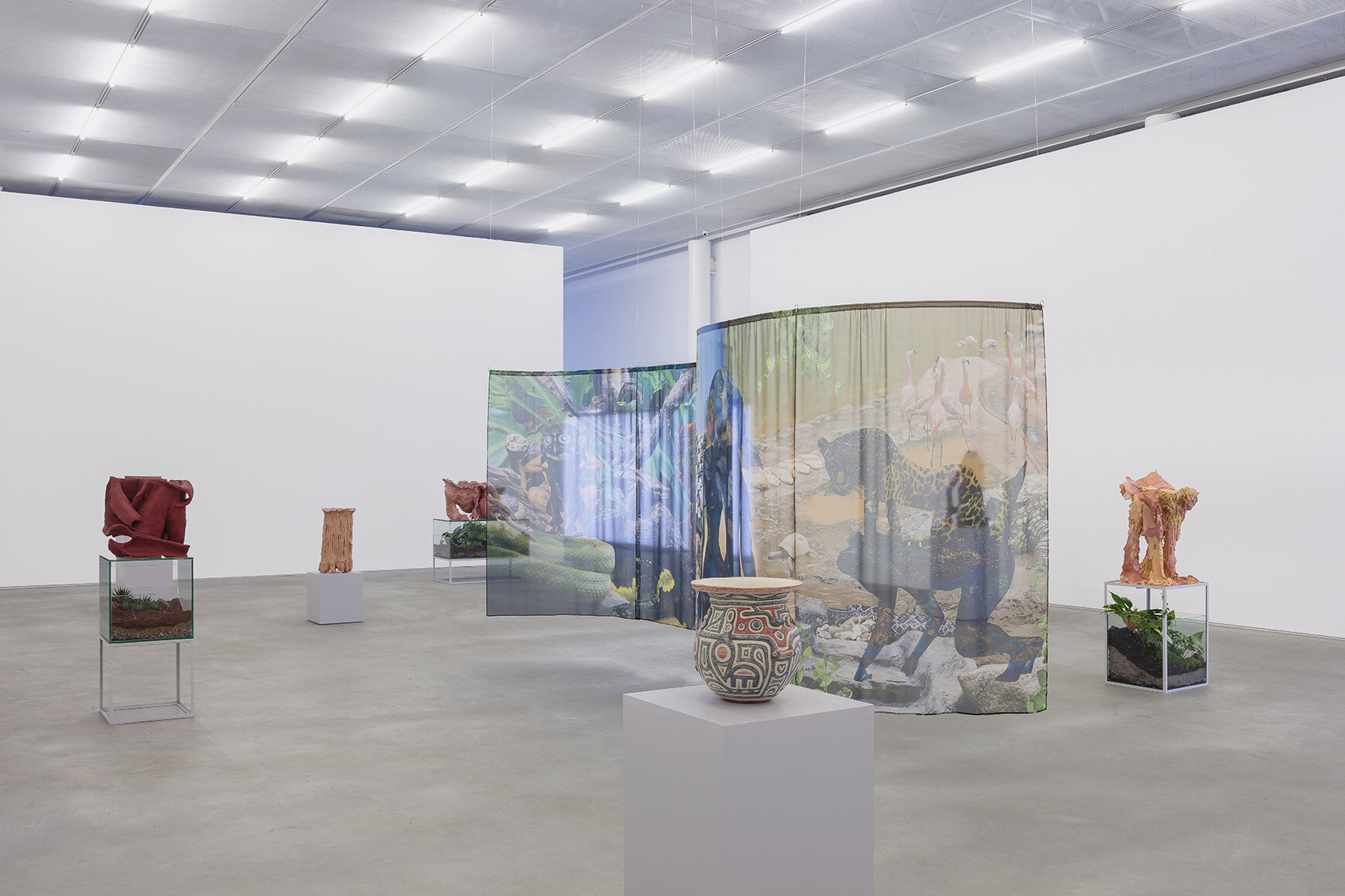HOTEL MARAJOARA, Casa Triângulo, São Paulo/SP, Brazil, 2020
HOTEL MARAJOARA, 2020
Casa Triângulo, São Paulo, Brazil
Exhibition view
HOTEL MARAJOARA
Throughout her career, Juliana Cerqueira Leite has carried out investigations into the human body and the history of its depiction. In this show, the artist extends her research by proposing a reflection, based on familial memories, in regard to how we construct the definitions of what we consider culture, or not.
During the 1980s, Juliana’s uncle brought ceramic objects produced in Pará to commercialize in São Paulo. These objects, popularly known as marajoara, are currently found throughout the country in stores selling “typically Brazilian” products, and are highly demanded as decorative objects. Investigating the origin of these items through research in the archaeological collections of various museums, the artist identified that the decorative ceramics from the north of Pará are formally descendent from Amerindian funerary urns, produced in the same region for nearly four thousand years.
In Hotel Marajoara, Juliana Cerqueira Leite presents a series of sculptures, replicas of urns, drawings, video and digital collage that proposes a dialogue with the urns produced by the cultures of the original peoples until the loss of this practice due to colonization. For these cultures, the body is what allows for the human identity of the soul. For its part, the soul, losing its body at death, can be incarnated in another animal in a dangerous process of transformation. In this process, the urns operate as objects serving as a place for the dwelling and transformation of the ancestor’s soul.
In the exhibition, three replicas of Amerindian funeral urns, of the Maracá, Aristé, and Marajoara traditions, are presented. Originating from the Replicando o Passado [Replicating the Past] project – a joint effort between the Museu Emilio Goeldi and ceramist masters from Icoarací, in Pará – these works were produced at the same time as the artist’s. The video brings us into the collection storage spaces of the museums where these funerary urns are found today, tracing a narrative about the collapse of cultures and the loss of the body.
The exhibition also includes two works from the artist’s Corpos Moles [Soft Bodies] series, which lead us to the inner space of the body in decomposition. The sculptures are composed of interlocking rings of paper, hung on the wall, forming a cellular totem. Moistened with plaster, this paper structure is deformed, compressed by gravity as it hardens, giving rise to a form which is simultaneously a process.
HOTEL MARAJOARA
HD video with color and sound 8'01"
This video was produced in 2019 and 2020 following a two-year research project within the archaeological departments of the Emilio Goeldi Museum in the city of Belém, and the Museum of Archaeology and Ethnography of the University of São Paulo. The video was filmed on location at both Museums' archaeological reserves and additional footage was filmed in São Paulo. The film captures Amerindian funerary urns from the Maracá, Marajoara, Aristé, Aruã, Tapajonica, and Guarita cultures.
HOTEL MARAJOARA, 2020
Casa Triângulo, São Paulo, Brazil
Exhibition view
URNA 8, 2020
Casa Triângulo, São Paulo, Brazil
dental plaster, fiber glass, aluminum, steel, pigment, glass base, live plants and organic substrate
unique, 126 x 105 x 55 cm
HOTEL MARAJOARA, 2020
Casa Triângulo, São Paulo, Brazil
Exhibition view
MEDIATED ANIMALS, 2020
Casa Triângulo, São Paulo, Brazil
permanent digital printing on polyester chiffon
ed. 3, 182 x 620 cm
URNA 6, 2020
Casa Triângulo, São Paulo, Brazil
plastered bandage, dental plaster, fiberglass, pigment, varnish, tempered glass base, iron, soil, organic substrate and live plants
unique, 135 x 45 x 45 cm
URN MARAJOARA JOANES, 2020
Casa Triângulo, São Paulo, Brazil
replica of archaeological pottery, 400-1400. Project Replicating the Past, Museu Emílio Goeldi, Belém do Pará, Brazil. Master ceramist: Marivaldo Sena da Costa, Icoarací unique, 29,5 x ø 29 cm
URN 7, 2020
Casa Triângulo, São Paulo, Brazil
dental plaster, fiber glass, aluminum, steel and pigment
unique, 58 x 33 x 33 cm
URNA ARISTÉ, 2020
Casa Triângulo, São Paulo, Brazil
replica of archaeological pottery, 1100-1600. Project Replicating the Past, Museu Emílio Goeldi, Belém do Pará, Brazil. Master ceramist: Marivaldo Sena da Costa, Icoarací unique, 48 x ø 35 cm
HOTEL MARAJOARA, 2020
Casa Triângulo, São Paulo, Brazil
Exhibition view
URNA MARACÁ, 2020
Casa Triângulo, São Paulo, Brazil
replica of archaeological pottery. Project Replicating the Past, Museu Emílio Goeldi, Belém do Pará, Brazil. Master ceramist: Marivaldo Sena da Costa, Icoarací
unique, 73 x 41 x 36 cm
QUADRUPED, 2020
Casa Triângulo, São Paulo, Brazil
stone plaster, acrylic, iron, aluminum, iron base, tempered glass, living plants, sand and organic substrate
unique, 141 x 46,5 x 46,5 cm
UNTITLED, FROM THE SERIES “STUDY ON REPETITIVE MOVEMENTS”, 2020
Casa Triângulo, São Paulo, Brazil
graphite and coloured pencil on paper
unique, 85 x 66,5 cm
MEDIATED ANIMALS, 2020
Casa Triângulo, São Paulo, Brazil
permanent digital printing on polyester chiffon
ed. 3, 182 x 620 cm
UNTITLED, FROM THE SERIES “STUDY ON REPETITIVE MOVEMENTS”, 2020
Casa Triângulo, São Paulo, Brazil
graphite and coloured pencil on paper
unique, 85 x 66,5 cm
UNTITLED, FROM THE SERIES “STUDY ON REPETITIVE MOVEMENTS”, 2020
Casa Triângulo, São Paulo, Brazil
graphite and coloured pencil on paper
unique, 85 x 66,5 cm
UNTITLED, FROM THE SERIES “STUDY ON REPETITIVE MOVEMENTS”, 2020
Casa Triângulo, São Paulo, Brazil
graphite and coloured pencil on paper
unique, 85 x 66,5 cm
SOFT BODY 2, 2020
Casa Triângulo, São Paulo, Brazil
dental plaster, glass fiber, aluminum, steel and pigment
unique, 189,5 x 65,5 x 30 cm
HOTEL MARAJOARA, 2020
Casa Triângulo, São Paulo, Brazil
Exhibition view



















